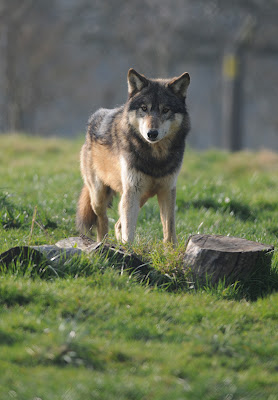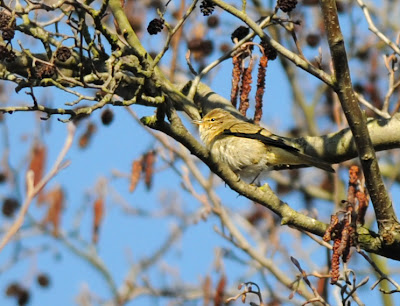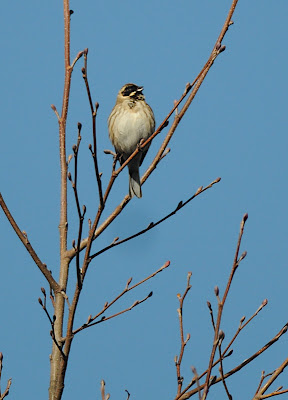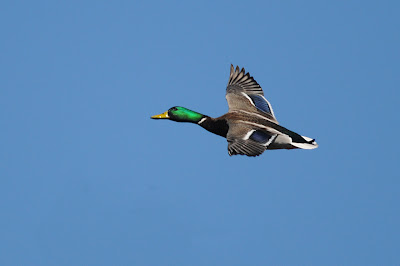Yesterday I went to Barnes (London Wetland Centre, WWT London, the duck place of many names) to meet Graham C and Shan from the RSPB forums. It started off sunny, then turned gloomy, then sunny again (and very warm) and finally a bit cloudy to finish. Took the first off-peak train, which got me to the centre at almost 11am. Soon I spotted Shan and Graham weaving through the throngs of school party children, and we set off to look in the hides on the east side of the reserve. The trees that lined the trail were alive with birdsong.
Tell me if you are getting bored with Long-tailed Tit photos. This one just kept bobbing closer and closer, obviously wanting to check out our optics.
A lovely male Greenfinch, fresh from a bath in the nearby lake. Also in evidence were Chiffchaffs and Goldfinches.
Wild duck numbers are pretty low now. Maybe the Shovelers will stick around to breed, I'm not sure. There were a couple of dozen Teals about too, and a similar number of Wigeons on the grazing marsh.
Lapwings were whooping and wheeling about over the main lake, though none were really close enough for decent photos. This one is helpfully pointing out one of the five or so Redshanks that were also about.
In the World Wetlands centre we witnessed this mother Mallard leading her 14 babies across the path to water, perhaps on their very first day of life. Ahhh.
If the bird's too close for the lens, it's portrait time. Here's a splendid drake Mallard who was sitting on the bridge handrail next to the Eiders' enclosure.
And here are some of the captive Eiders, going nuts for a handful of ducky kibble.
A very tame but full-winged so apparently wild Egyptian Goose. Got to love that thoughtful amber eye.
I'd hoped for better pics of this yellow-billed Moorhen, an intriguing example of pigmentation weirdness. Still, without Graham there to show me where she lived, I might not have seen her at all.
What else did we see? Not that much, to be honest. There've been recent sightings of Bittern and Water Pipit but we had no joy, nor did we see the Brambling supposedly frequenting the feeding station. I got desperately bad photos of a small bird which proved, on maximum cropping, to be a Lesser Redpoll, and also a Stock Dove going overhead. There were Ring-necked Parakeets around, as ever, and before I arrived Shan and Graham had good views of Green Woodpecker, and also saw a Cetti's (I heard a few but not a sniff of a sighting). But never mind the birds, the company was great, the light was photo-friendly and the day as a whole was excellent.
Tuesday 22 March 2011
Sunday 20 March 2011
An audience with wolves
Today, I went to the Wolf Conservation Trust near Reading with Michele, Carol and Steve. M is a member and gets to bring guests along to 'wolf walks', wherein we walk with a wolf, learn all about her and even get to give her a stroke. The trust uses these socialised 'ambassador wolves' to spread the word that wolves are great, and to raise funds for wolf conservation projects in Europe and further afield.
On the walk itself, I left the camera in the car as the safety instructions hinted that the wolf may think 'ooh, shiny dangly thing' and try to pinch it. So I can just tell you about that bit. We walked first with a 13-year-old called Duma. I forget where she came from, but she was a light-coloured, slim and not very fluffy wolf, very sweet-natured, happy to stand around while a bunch of strangers took turns to stroke her tum. Then Duma went away and was replaced with Mai, a younger and somewhat friskier wolf with a black-and-silver colour scheme. The wolves led the way and dictated the pace. Both stopped often to scent-mark, and Mai had a bit of a howl - seeing and hearing that at close range was incredible.
After the walk, we visited all seven wolves in their enclosures. The only one I could get decent photos of was Motomo, Mai's mate, as he is not socialised and so didn't come right up to the wires to say hello.
What a handsome boy. He was yawning, a good excuse to show off that mouthful of impressive gnashers.
Nothing has a stare quite as full-on as a wolf.
Naturally, I had one eye on the sky for interesting birdlife, especially as we were in Red Kite country.
The handlers told me that the kites sometimes drop down into the wolves' enclosures and swipe their food. Two species coexisting as nature intented (sort of).
We saw some kites at very close range, and some in beautiful light. Unfortunately we didn't see both of those things at the same time. You can see what a massively bulging crop this one has, though.
Not every soaring raptor around was a kite. This one, for example, was a Kestrel. There were also plenty of Buzzards around.
A surprise to end with - this stonking male Yellowhammer was weighing up whether to visit the European wolves Lunca and Latea in their enclosure.
To find out more about the UK Wolf Conservation Trust, go here.
On the walk itself, I left the camera in the car as the safety instructions hinted that the wolf may think 'ooh, shiny dangly thing' and try to pinch it. So I can just tell you about that bit. We walked first with a 13-year-old called Duma. I forget where she came from, but she was a light-coloured, slim and not very fluffy wolf, very sweet-natured, happy to stand around while a bunch of strangers took turns to stroke her tum. Then Duma went away and was replaced with Mai, a younger and somewhat friskier wolf with a black-and-silver colour scheme. The wolves led the way and dictated the pace. Both stopped often to scent-mark, and Mai had a bit of a howl - seeing and hearing that at close range was incredible.
After the walk, we visited all seven wolves in their enclosures. The only one I could get decent photos of was Motomo, Mai's mate, as he is not socialised and so didn't come right up to the wires to say hello.
What a handsome boy. He was yawning, a good excuse to show off that mouthful of impressive gnashers.
Nothing has a stare quite as full-on as a wolf.
Naturally, I had one eye on the sky for interesting birdlife, especially as we were in Red Kite country.
The handlers told me that the kites sometimes drop down into the wolves' enclosures and swipe their food. Two species coexisting as nature intented (sort of).
We saw some kites at very close range, and some in beautiful light. Unfortunately we didn't see both of those things at the same time. You can see what a massively bulging crop this one has, though.
Not every soaring raptor around was a kite. This one, for example, was a Kestrel. There were also plenty of Buzzards around.
A surprise to end with - this stonking male Yellowhammer was weighing up whether to visit the European wolves Lunca and Latea in their enclosure.
To find out more about the UK Wolf Conservation Trust, go here.
Early signs of spring
This weekend has been gorgeous, and for once I've been out in it, making t'most of it etc etc. Up 5.30am on Saturday, I headed for Sevenoaks Wildlife Reserve. It had been a cold night, and there was frost all over everything on my walk down, which I'd timed a bit too early for good light on the birdlife of Lambarde Road.
This female Mallard was having a sit-down on the pavement, while her mate pillaged a nearby garden. I presume they had wandered there from Bradbourne Lakes, which has a sizeable population of streetwise Mallards. Much more approachable than the ones on the nearby reserve - do the populations really stay apart, or does the same bird behave like a pukka wild bird on a nature reserve, only to turn into a Hovis-scoffing, tame-as-you-like parkland ducky when it moves to the lakes?
Dunnock on a frosty Forsythia (I think) hedge, like many others he was singing his heart out, though stopped when I got too close and flew to a higher perch.
At the top of the drive down to the reserve, I found myself suddenly surrounded by Greenfinches, which is a pleasant experience if you haven't been scarred for life by Hitchcockian imagery. There must have been five different males all singing in the same small area, either from their twirly little songflight or a perch at the top of one of the Lleylandii trees.
Here it is - your promised sign of spring. It might be a pretty bad photo of a Chiffchaff but you can make out that he's singing. There were at least five different ones singing on the reserve, all very restless and keeping to the higher bits of the trees. It took a long wait to get even this poor shot.
Presumably, those geese which are going to breed this year are already in the paired-up stage at least, which makes me suspect this trio won't be joining in (or if they are, they're doing it in an interesting new way).
Early spring or late winter? This was one of two Redwings I saw - the other was singing high in a tree, and caused me some confusion because I haven't heard one singing for ages. The song is a bit shrill and musically lacking compared to other thrushes, but it's always nice to hear something different.
By Willow hide, I found this male Reed Bunting, sitting high in a small tree and tirelessly delivering his extremely boring song. Luckily he's not at all boring to look at, and is coming into full breeding plumage with just a bit of hind-crown still not completely black.
Wrens seemed to be everywhere. This one broke all the rules by actually hopping towards me and into better light as I stood there taking its photo.
I sat by Long Lake for a while (as I'd remembered to use my rucksack-that's-also-a-folding-chair) and got a few shots of passing Stock Doves, commuting between various large trees. Perhaps they are nesting in one of them. Unlike its big sister the Woodpigeon, the Stock Dove is a hole-nester, so has to duke it out with Jackdaws, Little Owls and so on for the best rotten trees.
While I was there, two Mallard drakes zoomed past in hot pursuit of a female. This is one of them. How could she refuse, when he looks this good? (Actually, we know that with female Mallards, refusal is often not an option anyway...)
Nice male Great Spot. I am scouring the treetops for Lesser Spots all the time but not had a sniff of one, but I did get the other two woodie species today by way of compensation.
I'll end with this lovely Song Thrush, who was singing with great verve and panache by the main trail. All in all, didn't see anything that exciting (best bird was probably a distant Shelduck from Tyler hide) but the weather and general springiness made it a highly enjoyable visit.
In the afternoon I went to Michele's mum's (M is living there for now, as she is in between houses). I spent the last half-hour of sunshine watching passing birds overhead, including a Buzzard winging its way west very purposefully, a couple of 'skeins' of Cormorants, and lots of Starlings including this one, organising a nest despite still being very much winter-plumaged.
This female Mallard was having a sit-down on the pavement, while her mate pillaged a nearby garden. I presume they had wandered there from Bradbourne Lakes, which has a sizeable population of streetwise Mallards. Much more approachable than the ones on the nearby reserve - do the populations really stay apart, or does the same bird behave like a pukka wild bird on a nature reserve, only to turn into a Hovis-scoffing, tame-as-you-like parkland ducky when it moves to the lakes?
Dunnock on a frosty Forsythia (I think) hedge, like many others he was singing his heart out, though stopped when I got too close and flew to a higher perch.
At the top of the drive down to the reserve, I found myself suddenly surrounded by Greenfinches, which is a pleasant experience if you haven't been scarred for life by Hitchcockian imagery. There must have been five different males all singing in the same small area, either from their twirly little songflight or a perch at the top of one of the Lleylandii trees.
Here it is - your promised sign of spring. It might be a pretty bad photo of a Chiffchaff but you can make out that he's singing. There were at least five different ones singing on the reserve, all very restless and keeping to the higher bits of the trees. It took a long wait to get even this poor shot.
Presumably, those geese which are going to breed this year are already in the paired-up stage at least, which makes me suspect this trio won't be joining in (or if they are, they're doing it in an interesting new way).
Early spring or late winter? This was one of two Redwings I saw - the other was singing high in a tree, and caused me some confusion because I haven't heard one singing for ages. The song is a bit shrill and musically lacking compared to other thrushes, but it's always nice to hear something different.
By Willow hide, I found this male Reed Bunting, sitting high in a small tree and tirelessly delivering his extremely boring song. Luckily he's not at all boring to look at, and is coming into full breeding plumage with just a bit of hind-crown still not completely black.
Wrens seemed to be everywhere. This one broke all the rules by actually hopping towards me and into better light as I stood there taking its photo.
I sat by Long Lake for a while (as I'd remembered to use my rucksack-that's-also-a-folding-chair) and got a few shots of passing Stock Doves, commuting between various large trees. Perhaps they are nesting in one of them. Unlike its big sister the Woodpigeon, the Stock Dove is a hole-nester, so has to duke it out with Jackdaws, Little Owls and so on for the best rotten trees.
While I was there, two Mallard drakes zoomed past in hot pursuit of a female. This is one of them. How could she refuse, when he looks this good? (Actually, we know that with female Mallards, refusal is often not an option anyway...)
Nice male Great Spot. I am scouring the treetops for Lesser Spots all the time but not had a sniff of one, but I did get the other two woodie species today by way of compensation.
I'll end with this lovely Song Thrush, who was singing with great verve and panache by the main trail. All in all, didn't see anything that exciting (best bird was probably a distant Shelduck from Tyler hide) but the weather and general springiness made it a highly enjoyable visit.
In the afternoon I went to Michele's mum's (M is living there for now, as she is in between houses). I spent the last half-hour of sunshine watching passing birds overhead, including a Buzzard winging its way west very purposefully, a couple of 'skeins' of Cormorants, and lots of Starlings including this one, organising a nest despite still being very much winter-plumaged.
Saturday 5 March 2011
A walk along the seafront
For a while I've had this weird idea that I should visit Hove lagoon. I think I must have seen a rarity reported there at some point, or something. Anyway, when I set off for a walk along Brighton seafront on Friday, that was the endpoint I had in mind. It was a gorgeous day and the chilly NE wind of Thursday had dropped. I walked down Lewes Road, found to my disappointment that the pier was closed, then went down onto the beach in search of gulls.
Found one! I found plenty, though the lack of variety was disappointing. Herring Gulls of all ages, a few Black-headeds and nowt else. Still, trying to get flight shots was an enjoyable challenge - easy enough against the sky, not so easy against a confusing backdrop of Brighton buildings.
There were Carrion Crows aplenty on the beach, feeding actively among the loafing gulls. These two had a brief tussle over a bit of seaweed.
This one had a strikingly professional gleam in its eye. It kept walking up to sleeping gulls and standing over them in a menacing manner
I paused alongside Sussex Heights and was rewarded (well, sort of) with a Peregrine overhead, so high it was just a speck. Cropped to within an inch of its life, you can just make out what it is.
There were quite a few Great Crested Grebes on the sea, mostly dozing in large rafts, but a few singletons were closer inshore and feeding, making very lengthy dives in the calm water. I sneaked as close as I could to this one between its dives. Wonder if any of this lot will be breeding this year - the established pairs back on my patch are already getting down to business, as it were.
Nothing else was moving offshore apart from a few Cormorants. I'm sure if you put in the hours you'd get other stuff, but not today.
Going through Hove, there are bowling greens and little ornamental gardens behind the rows of colourful beach huts. Here I found this shy male House Sparrow, but not much else.
On reaching Hove Lagoon, I was a bit disappointed to discover it was a rather small concrete-lined boating lake. However, it offered a good vantage point for photographing the gulls as they commuted between the lagoon and nearby Shoreham Harbour. Then it was time to begin the long walk back. I measured my route at about 8.5 miles in total - not a bad morning's work/walk. Here are some more pics.
Found one! I found plenty, though the lack of variety was disappointing. Herring Gulls of all ages, a few Black-headeds and nowt else. Still, trying to get flight shots was an enjoyable challenge - easy enough against the sky, not so easy against a confusing backdrop of Brighton buildings.
There were Carrion Crows aplenty on the beach, feeding actively among the loafing gulls. These two had a brief tussle over a bit of seaweed.
This one had a strikingly professional gleam in its eye. It kept walking up to sleeping gulls and standing over them in a menacing manner
I paused alongside Sussex Heights and was rewarded (well, sort of) with a Peregrine overhead, so high it was just a speck. Cropped to within an inch of its life, you can just make out what it is.
There were quite a few Great Crested Grebes on the sea, mostly dozing in large rafts, but a few singletons were closer inshore and feeding, making very lengthy dives in the calm water. I sneaked as close as I could to this one between its dives. Wonder if any of this lot will be breeding this year - the established pairs back on my patch are already getting down to business, as it were.
Nothing else was moving offshore apart from a few Cormorants. I'm sure if you put in the hours you'd get other stuff, but not today.
Going through Hove, there are bowling greens and little ornamental gardens behind the rows of colourful beach huts. Here I found this shy male House Sparrow, but not much else.
On reaching Hove Lagoon, I was a bit disappointed to discover it was a rather small concrete-lined boating lake. However, it offered a good vantage point for photographing the gulls as they commuted between the lagoon and nearby Shoreham Harbour. Then it was time to begin the long walk back. I measured my route at about 8.5 miles in total - not a bad morning's work/walk. Here are some more pics.
Subscribe to:
Posts (Atom)




























